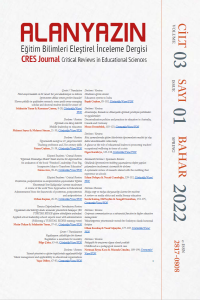Nitel Araştırmadaki On Bir Tuzak
Bu makalede; her yeni araştırmacının, nitel araştırma sürecinde karşılaşabileceği potansiyel tehlikeler incelenmekte ve bunlarla etkili bir şekilde başa çıkılabilmesi için uygun stratejilerden söz edilmektedir. Yazarın doktora ve yüksek lisans öğrencilerinin nitel araştırmalarında bir danışman olarak kişisel ve mesleki tecrübesi ile bu öğrencilerin nitel araştırmalarda düştükleri tuzaklar hakkındaki görüşleri, makalede kaynak olarak kullanılmıştır. Bu yazıda, araştırmacının araştırma programını planladığı hazırlık aşamasından, veri toplama ve analiz sürecinden, araştırma raporunun yazılmasının sonuna kadar mevcut dört aşamadaki on bir tuzak gösterilmektedir. Makale, bu tuzaklarla başarılı ve etkili bir şekilde nasıl başa çıkılabileceğini göstermek için faydalı olabilecek bazı stratejiler sunmaktadır.
Anahtar Kelimeler:
Araştırma deseni, tuzaklar, görüşme, doktora çalışmaları
Eleven Pitfalls in Qualitative Research
The current article analyzes potential pitfalls that each emergent researcher might face during the qualitative research process and illuminates adequate strategies to cope with them effectively. The author's personal and professional experience in supervising doctoral and MA students in their qualitative research and students' own reflections on the pitfalls they have faced are used as resources for this paper. Eleven pitfalls are depicted in this paper, divided into four phases in the research process, beginning from the preparatory phase in which the researcher plans the research program, through data collection and analysis, to the final phase of writing the research report. The paper provides some practical strategies to cope with these pitfalls successfully and effectively.
Keywords:
research design, pitfalls, interviewing, doctoral studies,
___
- Arar, K. (2017). The what's and why's of the how to of qualitative research. The Qualitative Report, 22(11), 2956-2958. https://doi.org/10.46743/2160-3715/2017.3272
- Baker, A. A., & Lee, J. J. (2011). Mind the gap: Unexpected pitfalls in doing classroom research. The Qualitative Report, 16(5), 1435-1447. https://doi.org/10.46743/2160- 3715/2011.1307
- Cooper, C., O'Cathain, A., Hind, D., Adamson, J., Lawton, J., & Baird, W. (2014). Conducting qualitative research within clinical trials units: Avoiding potential pitfalls. Contemporary Clinical Trials, 38(2), 338-343.
- Easton, K. L., McComish, J. F., & Greenberg, R. (2000). Avoiding common pitfalls in qualitative data collection and transcription. Qualitative Health Research, 10(5), 703-707.
- Elliott, N., & Jordan, J. (2013). Practical strategies to avoid the pitfalls in grounded theory research. Nurse Researcher, 17(4), 29-40.
- Froggatt, K. M. (2001). The analysis of qualitative data: Processes and pitfalls. Palliative Medicine, 15(5), 433–438.
- Hennink, M., Hutter, I., & Baily, A. (2020). Qualitative research methods. SAGE.
- Marshall, C., & Rossman, G. B. (2011). Designing qualitative research (5th ed.). SAGE.
- Niaz, M. (2009). Qualitative methodology and its pitfalls in educational research. Quality & Quantity, 43, 535-551.
- Oplatka, I. (2018). Understanding emotion in educational and service organizations through semi-structured interviews: Some conceptual and practical insights. The Qualitative Report, 23(6), 1347-1363. https://doi.org/10.46743/21603715/2018.3259
- Oplatka, I. (2017). Principal workload: Components, determinants and coping strategies in an era of standardization and accountability. Journal of Educational Administration, 55(5), 552-568.
- Patton, M. Q. (2002). Qualitative research and evaluation methods. SAGE.
- Strauss, A. L., & Corbin, J. M. (1990). Basics of Qualitative Research: Grounded Theory Procedures and Techniques. SAGE.
- Vaivio, J. (2008). Qualitative management accounting research: Rationale, pitfalls and potential. Qualitative Research in Accounting and Management, 5(1), 64-86.
- Yayın Aralığı: Yılda 2 Sayı
- Başlangıç: 2020
- Yayıncı: Öncü Okul Yöneticileri Derneği
Sayıdaki Diğer Makaleler
Regülasyon: Ahlaklılığın Bir İkamesi
Öğretmenlik Mesleği ve 21. Yüzyıl Becerileri
Erhan DOLAPCI, Necati CEMALOĞLU
Yükseköğretim Yönetiminde Önemli Bir Fonksiyon Olarak Kurumsal İletişim
Yetenek Yönetimi ve Eğitim Örgütlerinde Uygulanabilirliği
